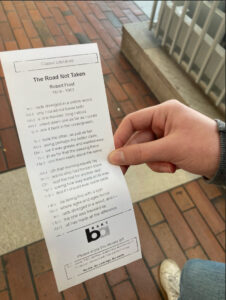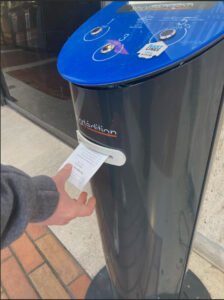In March 2021, Bay Area Rapid Transit (BART) faced many problems: plummeting ridership, phone theft and other issues brought on by the pandemic. But an email that arrived just before the pandemic seemed to be the answer to all of them. The proposal? To put free short story dispensers in BART stations. What started out as a one year pilot program is still going strong despite a few bumps in the road.
The email came from a French Company called Short Edition that produces short story dispensers. “[The idea] made its way to me and I loved it,” said Alicia Trost, BART’s Chief Communications Officer.
The idea was appealing for many reasons. Firstly, BART was suffering from the pandemic and needed a boost in ridership. When the program was rolled out in March of 2021, BART’s average weekday ridership was 51,595 people, according to the Metropolitan Transportation Commision. In January 2023, the average weekday ridership grew to 126,346 people. This is a result of people returning to in person work and school as the city continues its recovery from COVID-19.
Additionally, Trost viewed the program as a way to thank essential workers. “I loved the idea of offering them something free, almost as a reward, this concept of trying to bring joy in a time that was really stressful and scary,” she said.
Finally, BART was in the middle of a campaign to discourage people from looking at their phones in order to prevent phone theft. “We were pushing for a while to get people to read a newspaper, read a book, read a magazine. And so I loved this idea that we will even give you a short story that you can read instead of taking out your cell phone,” Trost said.
The plan proposed was simple: place touch free, short story dispensers in BART stations. People can choose between a one minute, three minute or five minute story.
In June of 2022, BART held a short story competition judged by well known Bay Area writers including J. K. Fowler, Daniel Handler, Annalee Newitz, Ishmael Reed and Ingrid Rojas Contreras. 30 stories were chosen that responded to the theme of “motion.” These stories are dispensed when someone chooses the five minute option. Trost said that the competition generated more readership because people would go to BART and try to get a story written by someone they knew.
Currently the five minute stories are the most in demand. Before the contest, the five minute stories were the least desired.

Photo by Olivia Bye
The distribution of stories is completely randomized from a database. The literature is a mix of well known and unknown authors including William Shakespeare, Robert Frost, Haley Swanson, R.L. Burke, Dennis Edelen and Alice Dunbar-Nelson. When someone selects a story, it is printed on long receipt-like paper. The paper itself is completely recyclable and thermal printing is employed to mitigate the use of ink.
Currently there are four dispensers. They are located at the Downtown Berkeley, Pleasant Hill, Fruitvale and Balboa Park stations. Trost said, “we looked at the data of what stations still have high ridership, one of which was definitely Fruitvale. We also have to enrich the Richmond station.” The Richmond dispenser was moved to Downtown Berkeley because of the student population there.
Balboa Park station was chosen because of the amount of students that use it. “I got to pick which stations to put them out and I knew right away Balboa Park had to be one of them, just because of all the young people that go through it,” Trost said. Pleasant Hill was the final station that was chosen due to its high ridership and because it was on the yellow transit line which had no other dispensers.
The initial cost of the program was $40,000. This included the four dispensers, maintenance (like fixing the machines when they break) and paper. Each dispenser cost $8,500. The money comes out of the $750,000 BART Communications Department budget, managed by Trost.

Photo by Olivia Bye
When Trost pitched the idea to her coworkers, most were immediately onboard. “For the most part, everyone loved and embraced the idea. They were just very nervous that [the dispensers] would be vandalized, which thankfully they haven’t been.” She said “when stations are pretty and you bring art to stations, there’s stats and data that show there’s less graffiti at that station. And people actually take care of it.”
The biggest problem that has come up regarding the dispensers is the issue of paper replacement. “Right now, someone at Short Editions is changing the paper for us. For a while three of my employees and people that worked at BART were going out and changing the paper,” Trost said. “We really need to figure it out. Someone that works in the station should change the paper because it makes more sense.”
BART also created content for its social media accounts to advertise the program. Due to BART’s budget, paid advertisements were not possible but word spread through social media, especially through a TikTok.
Charlotte Hahm ’24 learned about the program when her sister sent her a TikTok advertisement and told her there was one at Balboa Park. Hahm initially got a one minute story and sent it to her sister. “[Reading a story] made the experience better because it gave me something to look forward to instead of making BART something that I’m begrudgingly going to.” As of now, Hahm has gotten four stories from the Balboa Park dispenser.
LWHS English teacher and department chair, Michecia Jones, has gotten one story. “It was different, but I didn’t find it particularly compelling,” she said. Jones elaborated saying that she likes short stories that are different both in subject matter and structure. She will probably not be getting another story, especially because the dispenser at Balboa Park is out of the way for her.
Available stories cover a wide range of topics. The story Jones got, “Pitman,” was about a man who has always had a hard time going to bed and concluding with the satisfaction of sleeping once death comes. Jones described the story as “weird.” In addition to stories, the dispenser gives out poems and even drawings.
Unfortunately, there have been issues with the dispensers which have led to disappointed BART riders. Amieh Brooks ’24 attempted to get a story when she initially learned about the program from TikTok. “When I first found out about it, it wasn’t working. So I was like, ah, that’s kind of disappointing. There’s this cool thing and then it’s not working. Since then I haven’t paid any attention to it,” she said. Although Brooks has never gotten a story from a dispenser, she wants to.
Trost understands the need for the machines to continue to work. She said, “if somebody keeps coming up and trying to get a story and it’s always empty, they’re gonna no longer come and try to get a story. It has to be a great experience every time.” Unfortunately it seems like the machines are often broken. At some time, Brooks, Jones and Hahm have all attempted to get stories but were not able to because of machine malfunctions.
Additionally, not everyone wants to be reading on BART. People tend to ride BART because they need to, so they do things like look at their phones or listen to music to disengage from their commute. “I ride BART out of practicality — it’s consistently the fastest way to get to and from school,” Jones said.
Although not flawless, the program is going strong. As of January 26, 26,351 stories had been dispensed. Although those interviewed had not always had successful experiences with the distributors, they all had positive thoughts about the program.
There are still some issues with the program, but Trost is confident in its future. “It’s no longer a pilot program. We’re keeping these and we love them and we actually want to purchase more,” she said.







